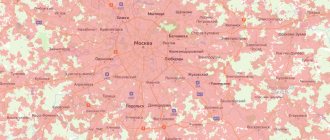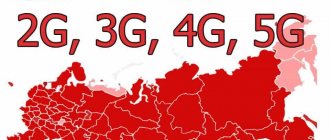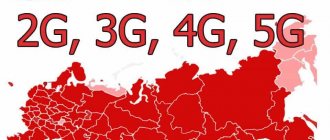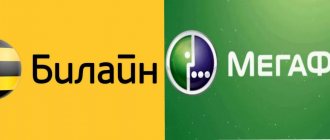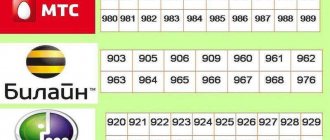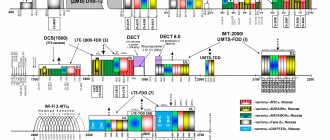The question of choosing a mobile operator is purely individual due to the different requirements of each of us: some need the cheapest and fastest mobile Internet, others need many minutes, and others generally need the opportunity to make inexpensive calls abroad.
Below we will compare the Big Four operators on such parameters as the quality of communication and mobile Internet, 4G coverage map and tariff availability, and also analyze user reviews, according to which a rating of Russian cellular operators will be compiled.
Which operator is better? Rating of mobile operators 2021 by quality and price
Mobile communications are something without which it is difficult to imagine life in the modern world, so it is not surprising that every mobile operator is trying to somehow modernize its services and capabilities in order to keep up with the times and not lose its regular customers.
That is why, when a user wants to change an operator or add another one, he uses ratings in order to understand which one is better to connect to and which one is better not to use. Rating:
- MTS;
- Megaphone;
- Beeline;
- Tele 2.
Beeline
Beeline is the third most popular operator, which owns 21% of the total cellular market in Russia. Currently, 54.3 million people use the provider’s services.
Connection quality
Beeline demonstrates good performance in terms of quality of communication services. Here is the data provided by Roskomnadzor:
- The average share of undelivered SMS is 1.5%;
- The percentage of unsuccessful attempts to establish a voice connection with another subscriber is 2.1%;
- Average speech intelligibility - 3.9 points;
- The average SMS delivery time is 6.4 seconds;
- The share of voice connection interruptions is 0.5%;
- The average proportion of voice connections with low speech intelligibility is 0.6%.
In terms of performance, the operator is significantly inferior to MTS, but in practice in Moscow, Beeline demonstrates a fairly high quality of communication. Calls are rarely interrupted, and there is virtually no background noise.
In the regions the situation is worse, but in the capital, Beeline’s results are on par with MTS and significantly better than Megafon’s.
Internet connection
More recently, Beeline could not boast of high Internet speed, but in 2021 the situation has changed. Now the operator can compare with the leaders in this industry - Megafon and MTS. The average Beeline download speed in 2021 ranges from 10-12 Mbit/s, upload speed is around 2.5 Mbit/s. The weak side of the Beeline Internet is stability. In Moscow, customers often complain about the inability to connect, Internet failures in buildings (especially in basements), and disconnections in the metro.
Tariff plans
Beeline recently released a new tariff plan that left most of its competitors far behind. This is the “Communication Z” tariff, which offers customers fireproof packages of traffic, minutes and SMS messages. Within the framework of this tariff, the subscriber can connect only those services that he uses and spend them for an unlimited time.
There is no subscription fee - money is only withdrawn when purchasing a new package when the old one ends. The “Communication Z” tariff plan, which includes 10 GB of traffic and 100 SMS, will cost a Moscow subscriber 500 rubles. Yes, it’s not cheap, but the packages are guaranteed not to burn.
Rating of mobile operators in 2021
Ratings of mobile operators and their popularity indicators are set by statisticians who monitor the work and use of these networks, what rednecks they received, how many new clients came, how many left, etc. Indeed, a lot of criteria are calculated, each of them creates its own indicator, which are summed up and get the average result, which everyone sees in the year’s ratings.
Rating of mobile operators 2021:
- MTS;
- Megaphone;
- Beeline;
- Tele 2.
These 4 mobile operators are the most popular among all Russian users and inspire confidence in many customers with their quality of work.
Mobile number format
The codes of Russian mobile operators are 9XX. A cell phone number contains 10 characters in total, but is often written in the format 89ХХ-ХХХ-ХХ-ХХ or +79ХХ-ХХХ-ХХ-ХХ. The second option is international and is used for recruiting from abroad. Cellular operator codes do not have a geographic correspondence like regular telephony. Therefore, for such codes you can also find names such as non-geographic or def codes.
For cellular operators in Russia, 100 codes have been allocated: from 900 to 999. Today 79 are used, 21 have not yet been distributed. The code allows you to set the operator by mobile phone number. You can also use it to find out how many numbers are reserved for this code and in which Russian regions it is used.
Before the introduction of the MNP service (Mobile number portability - the ability to transfer a mobile number to another operator), large operators owned large series of numbers, others sometimes only one series.
Beeline had only 24 codes: 900 902 903 904 905 906 908 909 950 951 953 960 961 962 963 964 965 966 967 968 969 980 983 986.
MTS had 26 codes: 901 902 904 908 910 911 912 913 914 915 916 917 918 919 950 978 980 981 982 983 984 985 986 987 988 989.
Megafon had 25 codes: 902 904 908 920 921 922 923 924 925 926 927 928 929 930 931 932 933 934 936 937 938 939 950 951 999.
And Tele2 had the fewest of the big four, only 18 codes: 900 901 902 904 908 950 951 952 953 958 977 991 992 993 994 995 996 999.
Dear friends, now that the service of porting mobile numbers to other operators while preserving the number (Mobile Number Portability, MNP) has existed for many years, the number of codes for operators has changed and is almost equal to the total number of def codes!!
People's rating
This indicator has its place, but basically, it can be attributed to the reviews that users leave after the conversation has ended or they have used the Internet.
If we talk in more detail about the reviews, then MTS is one of the best mobile operators for users, since it receives and maintains communications throughout the country, and no matter what region you go to, in any case you will be able to contact with the help of MTS. Thanks to this advantage, MTS is the most numerous communications dispatcher, which has about 80 million users.
Megafon earned its popularity and loyalty thanks to its rapid modernization, so it became the very first communications dispatcher to introduce 4G. In addition, Megafon has the most convenient application among all operators and is slightly inferior to MTS in terms of the number of users.
Beeline has been losing its popularity in recent years, although when everything was just in its infancy, it was the founder of everything new in the world of mobile communications and the Internet. At the moment, the operator has one of the lowest indicators, but many users are still loyal to it.
Tele2 is a young operator that has recently entered the market. It has a large number of towers in all regions of the country and is already catching up with the market leaders.
Story
A significant part of the pioneering companies has been erased by time. The balance of power changed dramatically many times.
Delta Telecom
Today, the first company in the USSR represents the infrastructure of the Sky Link brand (a division of Tele 2). After the dispersal of the State Emergency Committee, the operator began to develop the North-Western part of the Russian Federation, introducing the Scandinavian standard NMT-450. We mentioned earlier the fact that there was a sincere response from the Soviet leadership regarding mobile communications of senior management. The Altai system (born in 1963) then (the collapse of the USSR) managed to occupy a number of cities. The first Delta Telecom radio tower took a bite out of the infrastructure. Altai used UHF frequencies close to the Scandinavian 1G generation standard.
The capacities involved in cellular communications are 15 years old. August 1992 gave the country beginning a hunger strike a second tower, the Vyborg one; the first four years of activity brought 10 thousand subscribers. The analog standard was used until 2005 inclusive, capturing the lion's share of the country. Pressing competitors forced them to seek salvation by merging (2003) with other providers, primarily the Sonet trademark, Personal Communications Company (formed on August 17, 1998).
The consolidated brand was named Sky Link and used 2G+ generation CDMA digital technology. Gradually, there has been a tendency to absorb Russian Tele 2:
- 2014 replacement of management by Tele 2 personnel.
- January 2015 – decision to reunite.
- October 1, 2021 – official termination of CDMA services.
Beeline
The founding of Vympel Communications lasted for a year. Organized on the basis of TRI named after A.L. Mints, a group of engineers gathered forces. June 1992 brought the first AMPS tower to the Foreign Ministry building (Moscow), serving 200 subscribers. The test call was made on July 12, 1992. There was already a second generation digital version - D-AMPS.
- On July 16, 1992, Dmitry Zimin took over the position of general designer.
- On September 15, VimpelCom was finally registered.
- On January 11, 1993, a license was received to provide AMPS services to the capital. In the fall, there were 5 base stations, the number of subscribers doubled.
Having taken the initial steps, the team was puzzled by the development of marketing tactics. On August 6, we came up with the Beeline brand (bee network) and launched advertising. AFK Sistema (founder of MTS) immediately acquires a controlling stake. The network with a capacity of 10 thousand subscribers, created in the summer of 1994, began to be modernized by purchasing D-AMPS equipment. The transformation took 1 year, giving happy users of the company's services the first automated 24/7 technical support service.
In the spring of 1996, AFK Sistema sold shares, and Dmitry Zimin received a controlling stake. Some shares reach the New York Stock Exchange. In parallel, the development of the European progressive standard GSM-1800 is underway. The 900 MHz band is occupied by competitors, and building a network costs a pretty penny. Beeline was the first to offer Muscovites (1998) a prepaid card payment system. On October 18, 1999, the kits (phone, coupon worth $10) went on public sale. The result of the end of the year is the seizure of leadership (352 thousand subscribers = 47% of the market).
June 2001 brings the country the Internet (GPRS), Dmitry Zimin leaves the post of general director, receiving a nominal honorary position of the company. The structural restructuring was caused by the sale of part of the shares to foreign investors. The consistent introduction of new technologies continues:
- MMC (2002).
- EDGE (2004) – modification of GPRS.
On November 17, 2007, the use of obsolete D-AMPS technology ceased. Subscribers automatically received (finally) the second generation of mobile communications (2G). On September 1, 2008, the development of the third generation of digital wireless information transmission begins. Supporting modernization, Beeline sells new Huawei phones to customers. CDMA lasted longer (January 1, 2011).
The holiday brought by general modernization was spoiled by Megafon, which lowered prices, snatching up a fair share of the bee network’s clients. An observant expert noted: the lack of investment, flavored with increased prices, brings a stable result. In response, VimpelCom instructed Euroset to open at least 1,000 Russian representative offices. In subsequent years, Beeline tried unsuccessfully to win back. The company's policy included close cooperation with the state. The operator was the first to “remove” roaming (2017); similar attempts were made two years earlier (2015).
The transnational corporation VEON (VimpelCom) is formed by a number of separate divisions (Ukraine, Russia, Algeria, Pakistan, Laos, Bangladesh). Having secured parental support, Beeline tried to conquer neighboring countries. The Vietnamese experience is instructive, forcing the company to write off losses of $500 million from its own share of the subsidiary's infrastructure. The Eastern brothers received a completely ready-made third generation network. The brand is gradually losing value; experts blame the lack of attention paid to advertising in the period 2009-1010.
MTS
While Delta was mastering NMT-450, Beeline was developing AMPS, the Radio Research Institute, with the support of the Ministry of Defense Research Institute, was exploring the possibility of using the 900 MHz spectrum. It turned out that mobile communications get along well with aviation navigation. On July 25, 1992, it was decided to simultaneously develop two bands of 450 and 900 MHz. Since they decided to give the first standard to Delta, the MTS organizers were tasked with organizing a second-generation GSM digital network. The companies created the Mobile Moscow consortium:
- Moscow city telephone network.
- M-Bell.
- ASVT.
- NPO Astra.
- FAPSI.
- MPS.
- Canadian company BCETI.
MTS, being the brainchild of the mentioned organizations, was registered on October 28, 1993. Some participants gave in, and the final lineup included Siemens and Deutsche Telekom. Russia received a controlling stake. The first base station decorated Yablochkova Street on a May day in 1994, on July 7 the total number was 8, calls were launched. In 1996, the Russian share of shares was bought by AFK Sistema, the next year was devoted to the conquest of the capital company of Russia. In parallel with Beeline, the growing MTS is mastering the second generation of GSM mobile communications, introducing per-second billing.
The mid-2000s was the heyday of the company, which had previously been inferior to Beeline. The apogee of marketing policy was the introduction of the first free tariffs in the home region. Subscribers were given the opportunity to purchase SIM cards for families, receiving 30 minutes of free calls to their circle of loved ones. At the same time, the “identical” logo decorated the streets of cities, attracting everyone’s attention. 2008 was the date of the emergence of third generation networks, MTS became a partner of the British Vodafone.
Imitating Beeline, the company is conquering foreign countries (mainly the CIS). The fourth generation of mobile communications is based on the Yota infrastructure. In 2006, a loyalty program was launched. Years have eroded the habits of marketers; some subscribers have stopped receiving bonuses; re-registration is required in the operator’s personal account. Points expire regularly. This feature is vitally important to know for those wishing to receive a reward. Today the operator is creating virtual providers together with Russian companies.
Megaphone
Evgeny Kesarev (1992) visited St. Petersburg, planning to promote software designed to simplify telephone payments. The entrepreneur began bypassing company management. Alexander Malyshev (St. Petersburg MMT) accepted the proposal to create the Neva digital network. The partners began looking for an investor. Bo Magnusson (Telia International) agreed. Finnish Sonera and Swedish Telenor and Telia wanted to become shareholders (spring 1993).
The company was founded on June 17, 1993, the authorized capital is $17 million, and was originally named North-West GSM CJSC. Alexander Malyshev received the post of General Director. Journalists immediately visited St. Petersburg, making up the audience for the audience. The organizers among themselves called the idea an adventure. Europe had introduced the second generation a few years earlier; GSM was new to Russians. The first stage of network deployment included 12 towers.
Nokia network core equipment (switch, 12 base stations) cost $10 million. There was a shortage of equipment. The first call took place on August 25, 1994. 17 months later, on January 17, 1995, commerce began. The company gave the sales segment to the executive network of salons, using prepayment (unwillingness to pay off debts). The first year, which brought the figure of 8 thousand subscribers, exceeded the plan three times.
Finnish (Telecom Finland) and Norwegian (Telenor) companies received 49% of the shares. Residents of the Northern capital were able to talk from abroad while carrying heavy mobile phones. The company faced time pressure: lack of money for network development. The following steps demonstrate the ability of the new leader, Alexander Nyago, to pivot:
- Loan of $3 million (six months) from the Finnish bank Merita.
- The new money was immediately spent on purchasing base stations.
- The next loan of $9 million helped pay off Scandinavian debts.
- Along the way, Megafon covered St. Petersburg.
- The turning point was the receipt of $40 million provided by the European Bank for Reconstruction and Development.
1996 bears fruit: the number of subscribers catches up with Delta (24 thousand). A year later, the company's share is 53% of the market. Nyago's successor continued the course. Then follows a historical move that changed Beeline's policy. On December 1, 1998, a marketing gimmick was launched: charging only on the days the phone was used. In the winter of 1999, the number of subscribers quadrupled. Megafon became the first to develop the St. Petersburg metro and bought up the infrastructure of a competitor. National roaming (single numbers) became an individual achievement of the company, replacing city codes. Russian operators provided the service later. Seeing Moscow competitors (Beeline, MTS), North-West GSM decided to create a memorable brand. The new name has no regional reference.
This is interesting! The company's management intended a megaphone to be used by speakers who filled the stands. The younger generation refused to accept the forgotten term of Soviet times.
Modifications to the structure of tariff plans quickly bore fruit. The flexible policy generated 150 thousand subscribers (June 2001). For the first time, there was a clash of interests: mutual penetration of two capitals into foreign territory. Megafon captured 10% of the Moscow market. On January 21, 2002, the office was visited by the millionth client who received a VAZ-2110 car. The prank continued.
The development of the third generation began on time - 2008 (38.5 million subscribers), the operator was the first (October 2, 2007) to launch the UMTS network (St. Petersburg). Parallel to other providers. The company immediately began selling Huawei E680 gateways that support mobile gadgets, providing access to the Internet. The kit was supplied with a suitable tariff. The market share was 29%. Today Megafon shares Yota LTE capacity with Beeline. There has been a trend of consolidation, caused by the general economic crisis caused by the Crimean events.
Tele 2
The founder of Tele 2 Russia is a transnational telecommunications company. In 1981, a competitor to the cellular operator Televerket (Telia) appeared. The company was named Comvik, later (1986) cable television provider Kabelvision AB was born. In 1988, Comvik received a GSM license, changing its name. The updated Comviq began work in 1992. Three companies merged:
- Comviq.
- Kabelvision.
- Internet provider.
The concern received the name Tele 2. The mobile market began to capture Estonia, Latvia, Russia (2001), France. The American roots of the parent companies led to the use of North American D-AMPS technology. In 2001, the US said arividerchi, selling a stake in the business to the Swedes. Then they began to introduce European GSM. The deployment of the network was carried out, in addition to building its own infrastructure, by absorption. A new tactic became dominant - the Swedes bought ready-made infrastructure. On August 13, 2007, mutual cooperation between VimpelCom and Tele 2 began.
In the spring of 2013, the company was bought by the VTB Group, reselling 50% of the shares in the fall to Russian companies. On February 6, 2014, the integration of the Rostelecom-Tele 2 tandem began. Today, the operator continues to cover Russia with a 4G network.
Rostelecom
The company ranks first in terms of the number of subscribers (over 100 million) of Internet access. The mobile communications segment is much more modest. Substantial support is provided by the implementation of government programs. Legally, the company acts as the successor to the USSR Ministry of Communications. In February 2014, Rostelecom began to capture the mobile communications market by combining the infrastructure with Tele 2. Today, things are going neither shaky nor slow.
Yota
The new operator (2012) is devoid of the legacy of a difficult past - the scourge of all successful companies. Coverage of the regions with a new type of equipment, 4G technology, began immediately. Now the assets have been merged with Megafon. The history of the company's opening goes back 6 long years. Two entrepreneurs, Denis Sverdlov and Sergey Adonyev, agreed (2006) to create a WiMAX (3G+) network in Russia. Since Russian operators have barely completed the development of the second generation of equipment (GSM). In the fall of 2008, a trial launch was carried out in the capitals.
Noticing a global trend (2010), the owners decided to master LTE. Now the table of infrastructure by region has formed a solid list (48 pieces). At the same time, the new federal operator was selling modern communication devices to citizens: phones, laptops. In the summer of 2012, the merger with Megafon was completed. On August 13, 2014, SIM cards pre-ordered by subscribers began to be issued.
Rating by quality and price
The quality of Internet connection can be determined by the number of users. If, for example, Beeline has poor Internet speed and an insufficient number of towers, then there are not very many clients. MTS and Megafon, on the contrary, are installing more and more towers throughout the country, thereby attracting new customers, offering fast Internet and mobile communications, which are supported in almost every corner of the country.
The price, in turn, depends on the package that the client purchases. The package indicates the number of permissive minutes, MB and GB of Internet that can be used, as well as SMS. And the more allowed, the higher the price will be.
Megaphone
Megafon is the second most popular provider in Russia, with the widest coverage throughout the country. Currently, its services are used by 75.9 million subscribers, which is about 29% of the total cellular communications market in Russia.
Connection quality
Despite the impressive coverage map, Megafon is inferior to other operators in terms of the quality of communication services.
According to Roskomnadzor, Megafon demonstrates the following indicators:
- The average share of undelivered SMS is 1.1%;
- The percentage of unsuccessful attempts to establish a voice connection with another subscriber is 2.5%;
- Average speech intelligibility - 3.9 points;
- The average SMS delivery time is 4.5 seconds;
- The share of voice connection interruptions is 0.4%;
- The average proportion of voice connections with low speech intelligibility is 1.4%.
In terms of low speech intelligibility and the number of unsuccessful calls, Megafon is noticeably ahead of other cellular providers in Moscow. Similar data is reflected in customer reviews - subscribers often complain that calls are dropped, the sound disappears, and interference occurs during a conversation.
Internet connection
Megafone is doing much better with the Internet than with voice communications and SMS messages:
- Average download speed - 13.8 Mbps;
- Average upload speed is 2.4 Mbit/s.
Despite the high download speed, it cannot boast of a stable Internet connection. Communication does not work well in buildings and especially in the underground, it often breaks down, and can suddenly slow down for no particular reason.
Tariff plans
Megafon's tariffs are more interesting than those of MTS. The most budget tariff “Minimum”, included in the “No overpayments” line, can offer the following content:
- 300 minutes to all numbers in the region of your stay;
- Completely unlimited conversations with Megafon subscribers;
- 6 GB of mobile traffic at maximum speed;
- Messengers do not consume the traffic package and can be used even in the red.
The tariff also includes a “Piggy Bank” - it includes all the minutes and traffic not spent during the month. They can then be used at any appropriate time. The subscription fee is 390 rubles. per month.
Comparison of tariffs of mobile operators in 2021
Every year, mobile operators introduce new tariffs to the market, which always have some special features. But most of all now the emphasis is on the availability of mobile Internet. Moreover, tariffs with greater access are sold out first.
Operators will also come up with separate tariffs for young people and separate tariffs for older people.
Cost of services
Each operator provides a huge variety of tariffs; we will not analyze all of them, but will only compare the general characteristics. The cost of communication tariffs is dynamic, the average price in Russia for a package is 300-350 rubles/month. According to analysts from ComNews Research, when using a small basket (lack of mobile Internet, small number of calls and messages, focus on on-network calls), MTS became the most profitable operator. In other cases, which cover the majority of users (Internet, calls, messages), the best operator in terms of cost of services, both according to expert estimates and user reviews, is the Tele2 provider. The cost of the average package for all operators varies greatly depending on the service region, and in the Far Eastern and northern districts the values are uneven. If we take an assessment of the trends in the central regions, the cost of the average package varies in this order, from the cheapest to the most expensive:
- "Tele 2"
- "Beeline"
- "Megaphone"
- "MTS"
As we found out, each cellular provider has its own characteristics, and for this reason, many people use the services of several operators at once. Which one to choose is up to you, and making a choice is important taking into account your region of residence.
Break a phone number into parts
The first thing to do is to disassemble the phone into three parts:
- country code - for Russia it is +7 or 8;
- operator code - 3–5 digits (in fact, this is not an operator code, but a numbering zone code. I’ll tell you later);
- The actual phone number is 5–7 digits.
The numbering zone code for a mobile number always consists of three digits.
For a stationary one, out of three, four or five. To determine the region by phone number, in any case, the first three digits are enough. If you don’t know which part of the number consists of which digits, then it will not be easy. The solution is to put a mask so that users immediately enter numbers in parts. Or disassemble it later; the Google library for working with phones will handle the task.
Summary
It is difficult to definitely choose the best operator in Moscow and the Moscow region. In terms of overall communication quality, Tele2 and MTS are leaders, in Internet speed - Megafon and Yota, in terms of content and cheapness of tariff plans - Tele2 and Yota. If you call a lot, it is better to stick with Tele2 - this operator has the fewest problems with calls. But if you constantly use the Internet, take a closer look at Iota. The connection is very fast, and the designer will allow you to choose a tariff that is ideal for your needs.
Advertising war: MTS and Beeline
The competitive struggle between operators that appeared on the market almost simultaneously began almost from the very beginning. The public saw one of the most striking manifestations of the advertising war in the early 2000s. In 2001, VimpelCom released a video that played up the indignation of MTS subscribers that money periodically disappears from their accounts. In the advertisement, players who scored 10 goals found the score “0:0” on the scoreboard after the break. The voice-over said that “everything is in order at Beeline.”
American marketers call this type of advertising comparative, that is, comparative - the video indicates the disadvantage of the opponent and the advertiser’s lack of it. McDonald's and Burger King, Coca-Cola and PepsiCo often work against each other in the same way. In this case, to get the message, viewers must be aware of the pros and cons of the competing brands.
MTS’s response to its opponent’s advertising with its video became a little more obvious. In 2001, Beeline released a video “Tinsmith Day”, in which it advertised a new tariff plan - 500 minutes of talk for $50.
At the same time, MTS actively advertised its “Summer” tariff. The brand attracted the famous director Yuri Grymov, who played the main character of the competitor’s video - a car mechanic.
Grymov himself was not satisfied with his work: “I was against the appearance of the video “Competitors are resting” on air. It didn’t seem right to me.” According to the director, the idea of creation belonged to the MTS marketing service.
In addition, the operator used in its advertising another very popular Beeline video, in which the seller asks the buyer: “How much to hang in grams?”
MTS launched an advertisement on the “Holey Quality” radio, in which the seller was asked to weigh the cheese, and in response he asked: “Should the holes be hung together with the cheese or separately?”
Beeline did not respond to its competitor’s advertising attacks. “We believe that advertising is not the most suitable field for controversy of any kind, and we consider steps of this kind to be ineffective,” said Anton Mironov, head of VimpelCom’s marketing communications service. “Such polemics do not solve any marketing problems.”
In turn, the MTS press service stated: “Our competitors raised their business in Moscow not without the help of anti-advertising, in which they pointed out the imaginary shortcomings of MTS. All our videos that can be mentioned in the context of an advertising war have always been a response to certain moves by competitors.”
In 2005, VimpelCom CEO Alexander Izosimov began rebranding Beeline. It cost $2 million to create a new logo with the iconic yellow and black stripes. The transformation was carried out by the agency Wolff Olins, and the advertising promotion was handled by the agency BBDO.
When MTS released a new logo in 2006 in the form of a red background with a white egg, brand representatives said that the main focus was not on brightness, but on the feeling of stability that the brand name should evoke. The rebranding of the main competitor was carried out by the same agency Wolff Olins, but for $4 million. The BBDO agency was also entrusted with carrying out the advertising campaign.
A similar coincidence was already noted by the public in 1999, when the Beeline logo underwent minor changes, the most obvious of which was the replacement of a rectangle with a shape reminiscent of a SIM card. A little later, the image of the SIM card also acquired the MTS logo.
In 2007, Samsung intervened in the competition. To advertise its Samsung Duos phone, which supports two SIM cards, the company launched “Choose” billboards. This was the first stage of the advertising campaign.
Subsequently, a video appeared that urged operators not to quarrel over subscribers, because now users do not need to make a choice in favor of one.
In September 2006, a concert by the singer Madonna took place in Moscow. The official sponsor of the event was, which, according to experts, spent about $2 million on the star’s arrival. On the eve of the concert, the company held a ticket draw and invited subscribers to download videos and realtones of Madonna.
At the same time, MTS started a quiz for its subscribers - the winners received tickets to the same concert. The operator also suggested that users download the singer’s ringtones. Despite all the protests from representatives of VimpelCom, violations of the law in the actions of MTS could not be found. Experts called the issue more of an ethical issue than a legal one.
In 2005, a similar moment arose at the Moscow Kremlin Cup tennis tournament, sponsored by MTS. At one of the matches, a group of spectators appeared in recognizable black and yellow clothes. Representatives of VimpelCom commented that fans themselves have the right to choose what to wear to the tournament.
In 2009, an advertisement for Beeline appeared on Ukrainian television, in which mobile operators appeared in the images of different girls. The video directly addressed the shortcomings of other companies. The operator offered the public the “ideal tariff plan “29””, free of them.
In 2013, new Beeline banners with eggs and the slogan “Be Different” appeared on the streets:
In 2014, VimpelCom launched a commercial called “My Beeline.” As in the advertisement with the disappearance of the score on the scoreboard, in the new clip users saw an attack on MTS. Namely, a hint at the opacity of the account detailing function.
Russian rating from subscribers
What is the best cell phone carrier in 2022? You can look at a lot of TOPs on the Internet, but let us remind you that not all sites are independent and not all should be trusted.
Creating a popular rating is a difficult process. It takes a long time to accumulate reviews, check their reliability, remove fake and unreal ones. We show you a rating from a reputable resource that you can completely trust.
Suddenly, Tinkoff Mobile jumped to 1st place. Most likely, this is determined by substantial investments in the development of a truly good provider and the desire to take subscribers away from rivals. This is the right step, because the Russian cellular communications market is overflowing with offers and it is extremely difficult to break through.
